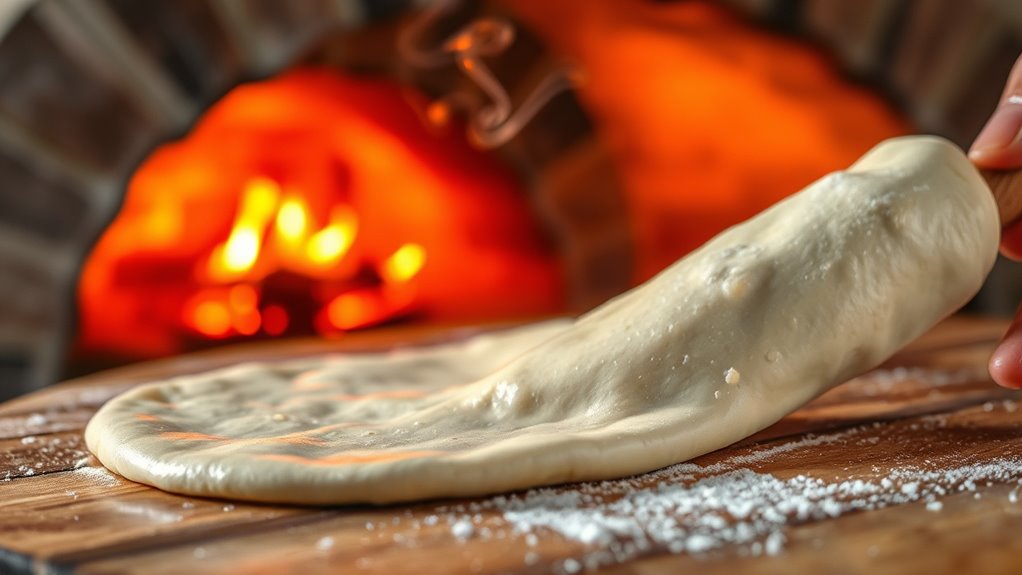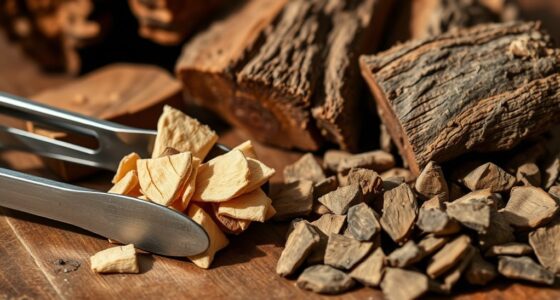To perfect pizza dough for outdoor ovens, focus on proper fermentation, such as cold fermentation for deeper flavor and better gluten development. Knead thoroughly and use techniques like stretch-and-folds to strengthen the gluten network, ensuring your dough can handle high heat. Balancing fermentation time and temperature improves elasticity and crust texture. Mastering these steps will help you create an authentic, flavorful crust that holds up well in outdoor setups—keep exploring for even more tips to elevate your pizza.
Key Takeaways
- Use cold fermentation (24-72 hours) to develop deeper flavor and better gluten structure for outdoor ovens.
- Knead and incorporate stretch-and-fold techniques to strengthen gluten and improve dough elasticity.
- Opt for autolyse to enhance gluten development before fermentation, ensuring a resilient dough for high heat.
- Maintain proper fermentation timing to prevent over- or under-proofing, optimizing oven spring and crust quality.
- Achieve the right dough hydration and fermentation method to produce a crispy yet chewy crust suitable for outdoor baking.

Making perfect pizza dough begins with understanding the fundamental techniques that influence its texture and flavor. One of the most critical aspects is mastering fermentation methods, which develop the dough’s complexity and enhance its taste. When you allow the dough to ferment properly, the natural sugars in the flour break down, creating a richer, more nuanced flavor profile. You can choose from various fermentation methods, such as a quick rise with warm water and shorter fermentation times, or a slow, cold fermentation in the refrigerator that can last 24 to 72 hours. Each method impacts the dough’s overall quality, so experimenting to find what suits your outdoor oven setup is essential. Cold fermentation, in particular, allows the dough to develop deeper flavors and improves gluten structure, which is essential for achieving that perfect chewy yet tender crust.
Speaking of gluten development, it’s an indispensable process that determines how well your dough stretches and holds its shape in an outdoor oven. When you knead the dough thoroughly, you encourage gluten strands to form and align, creating a stretchy network that gives the dough its elasticity. This process not only helps in achieving a light and airy crust but also ensures that your pizza can withstand high oven temperatures without tearing or collapsing. Proper gluten development results in a dough that’s easy to work with and produces a crispy, yet chewy texture once baked. To boost gluten formation, consider techniques like autolyse—mixing flour and water and letting it rest before kneading—or performing stretch-and-folds during bulk fermentation. These methods strengthen the gluten matrix without overworking the dough, leading to better oven spring and a more satisfying crust.
When preparing your dough for outdoor baking, keep in mind that fermentation and gluten development are interconnected. A well-fermented dough with proper gluten structure will respond better to the high heat of your outdoor oven, giving you that authentic, fire-kissed crust. Temperature and timing are key; too short a fermentation or insufficient gluten development can result in a dense or flat crust, while over-fermentation may cause the dough to collapse. Additionally, understanding the importance of dough texture and its relationship to fermentation can help you fine-tune your process for optimal results. By paying close attention to these techniques, you guarantee your pizza dough has the perfect balance of flavor, elasticity, and texture, making your outdoor pizza experience truly exceptional. Remember, the effort you put into mastering fermentation methods and gluten development pays off in every delicious, perfectly baked slice.
Frequently Asked Questions
What Type of Flour Is Best for Outdoor Pizza Dough?
You should use high-protein bread flour for outdoor pizza dough, as it promotes better gluten development and provides the strength needed for a chewy, airy crust. Its higher gluten content allows for improved flour hydration, creating a dough that’s elastic and easy to work with. This type of flour withstands the intense heat of outdoor ovens, resulting in a crisp crust with a tender interior.
How Do Outdoor Conditions Affect Dough Fermentation Times?
Ever wondered how outdoor conditions influence your dough? Humidity effects and temperature fluctuations can speed up or slow down fermentation, making it tricky to get consistent results. Warmer temperatures boost yeast activity, reducing fermentation time, while high humidity can alter dough hydration. Conversely, cooler or fluctuating temperatures might extend fermentation, requiring you to adjust proofing times. Stay attentive to weather changes to perfect your outdoor pizza experience.
Can I Prepare Dough in Advance for Outdoor Baking Sessions?
Yes, you can prepare dough in advance for outdoor baking sessions. Store your dough properly in an airtight container or wrap it tightly to prevent drying out. Refrigerate to slow fermentation, which enhances flavor development. When you’re ready to bake, let the dough come to room temperature. This method not only saves time but also improves dough flavor, giving you a delicious, well-developed crust for your outdoor pizza.
What Are Common Mistakes When Working With Outdoor Pizza Dough?
You might think handling your dough a lot improves it, but overhandling actually ruins its texture. Many beginners fall into the trap of improper proofing, either rushing or underestimating the resting time, which can lead to tough or flat crusts. To avoid these mistakes, handle your dough gently, respect the proofing process, and don’t rush the rising. Proper care guarantees a perfect crust every time, even in an outdoor oven.
How Do I Prevent Dough From Sticking to Outdoor Oven Surfaces?
To prevent dough from sticking to outdoor oven surfaces, focus on proper oven surface preparation and managing dough surface adhesion. Lightly dust the oven floor with flour or cornmeal before placing your dough. Make certain the oven is preheated and the surface is clean and dry. Also, stretch the dough evenly and avoid overly moist toppings. These steps help reduce sticking, making your pizza easier to slide in and out.
Conclusion
Mastering outdoor pizza dough techniques can transform your baking experience. Did you know that outdoor ovens can reach temperatures up to 900°F, allowing for perfectly crispy crusts in just minutes? With the right dough handling, you’ll impress friends and family alike. Remember, patience and practice are key. So, get your hands floury, experiment with different recipes, and enjoy the delicious results of your outdoor pizza adventures!









